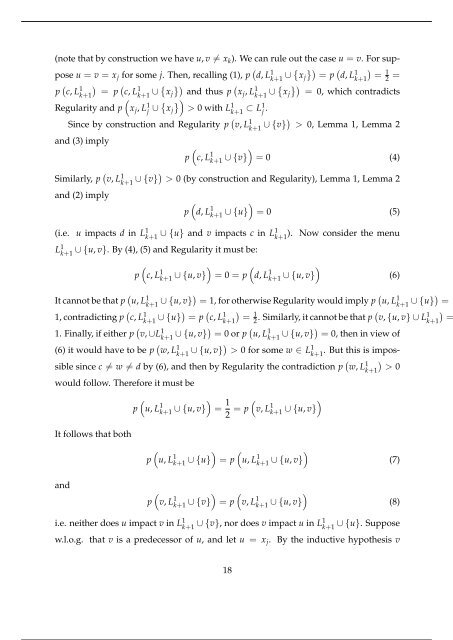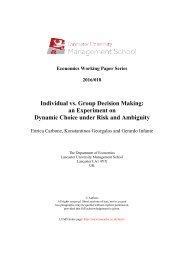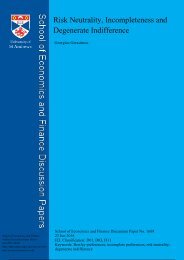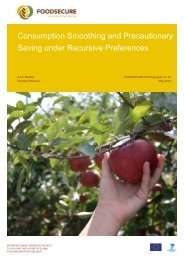Dual Random Utility Maximisation
n?u=RePEc:san:wpecon:1605&r=upt
n?u=RePEc:san:wpecon:1605&r=upt
You also want an ePaper? Increase the reach of your titles
YUMPU automatically turns print PDFs into web optimized ePapers that Google loves.
(note that by construction we have u, v ̸= x k ). We can rule out the case u = v. For suppose<br />
u = v = x j for some j. Then, recalling (1), p ( d, L 1 k+1 ∪ { x j<br />
}) = p<br />
(<br />
d, L<br />
1<br />
k+1<br />
) =<br />
1<br />
2<br />
=<br />
p ( c, L 1 (<br />
k+1) = p c, L<br />
1<br />
k+1<br />
∪ { }) (<br />
x j and thus p xj , L 1 k+1 ∪ { })<br />
x j = 0, which contradicts<br />
(<br />
Regularity and p x j , L 1 j ∪ { } )<br />
x j > 0 with L 1 k+1 ⊂ L1 j .<br />
Since by construction and Regularity p ( v, L 1 k+1 ∪ {v}) > 0, Lemma 1, Lemma 2<br />
and (3) imply<br />
)<br />
p<br />
(c, L 1 k+1 ∪ {v} = 0 (4)<br />
Similarly, p ( v, L 1 k+1 ∪ {v}) > 0 (by construction and Regularity), Lemma 1, Lemma 2<br />
and (2) imply<br />
)<br />
p<br />
(d, L 1 k+1 ∪ {u} = 0 (5)<br />
(i.e. u impacts d in L 1 k+1 ∪ {u} and v impacts c in L1 k+1<br />
). Now consider the menu<br />
L 1 k+1<br />
∪ {u, v}. By (4), (5) and Regularity it must be:<br />
)<br />
)<br />
p<br />
(c, L 1 k+1 ∪ {u, v} = 0 = p<br />
(d, L 1 k+1 ∪ {u, v}<br />
It cannot be that p ( u, L 1 k+1 ∪ {u, v}) = 1, for otherwise Regularity would imply p ( u, L 1 k+1 ∪ {u}) =<br />
1, contradicting p ( c, L 1 k+1 ∪ {u}) = p ( c, L 1 k+1) =<br />
1<br />
2<br />
. Similarly, it cannot be that p ( v, {u, v} ∪ L 1 k+1) =<br />
1. Finally, if either p ( v, ∪L 1 k+1 ∪ {u, v}) = 0 or p ( u, L 1 k+1 ∪ {u, v}) = 0, then in view of<br />
(6) it would have to be p ( w, L 1 k+1 ∪ {u, v}) > 0 for some w ∈ L 1 k+1<br />
. But this is impossible<br />
since c ̸= w ̸= d by (6), and then by Regularity the contradiction p ( w, L 1 k+1) > 0<br />
would follow. Therefore it must be<br />
)<br />
p<br />
(u, L 1 k+1 ∪ {u, v} = 1 )<br />
(v,<br />
2 = p L 1 k+1 ∪ {u, v}<br />
(6)<br />
It follows that both<br />
)<br />
)<br />
p<br />
(u, L 1 k+1 ∪ {u} = p<br />
(u, L 1 k+1 ∪ {u, v}<br />
(7)<br />
and<br />
)<br />
)<br />
p<br />
(v, L 1 k+1 ∪ {v} = p<br />
(v, L 1 k+1 ∪ {u, v}<br />
(8)<br />
i.e. neither does u impact v in L 1 k+1 ∪ {v}, nor does v impact u in L1 k+1<br />
∪ {u}. Suppose<br />
w.l.o.g. that v is a predecessor of u, and let u = x j . By the inductive hypothesis v<br />
18






